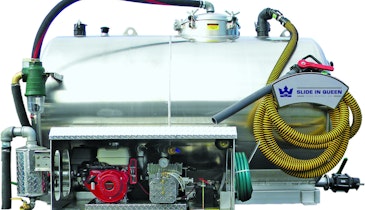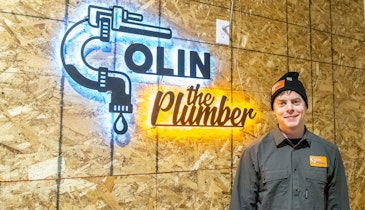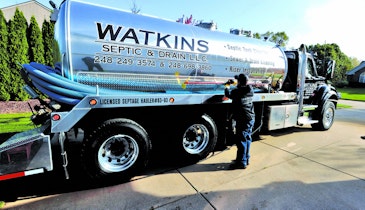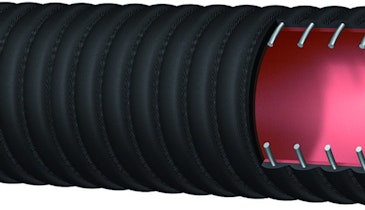Resource Geoscience Inc. in Colorado Springs, Colo., specializes in environmental assessment, compliance, and remediation services. One contract involves cleaning guano, half-dead pigeons, and maggots from the roofs of car washes and service stations before the debris clogs gutters. Besides harnesses and hard hats, the men wear full Tyvek suits and full face respirators because of the health hazards associated with pigeons. Suit sleeves are duct-taped around surgical-type gloves, followed by removable rubber.
Owner Tom Lewis and crew were cleaning guano one 80-degree day using a King Vac industrial vacuum loader from Keith Huber Inc. At that altitude, the machine produces 3,700 cfm with 22 inches mercury instead of the standard 27 inches. Lewis, who stands 6-feet, 1-inch tall, weighs 185 pounds, is 47 years old, climbs mountains like Everest and Kilimanjaro, and works out daily in the gym, was handling the 6-inch diameter whip hose.
Perspiration streamed down Lewis’ face shield, impairing his vision. As he reached down to move the hose to another pile of debris, the vacuum began sucking off his left-hand glove. Instinctively, Lewis made a fist and moved his hand toward the glove to catch it. In a millisecond, the flexible hose engulfed his entire arm, which immediately began to hurt. The terrible sound of silence followed as the hose sealed itself around his arm and chest.
Pumper: What makes the whip hose different from other vacuum hoses?
Lewis: It’s a plastic, flexible, corrugated hose used around French drains, houses, or downspouts. It wears quickly if you’re vacuuming metal or rock, but we just replace it because it’s cheap. It’s super light so it moves easily. The bad thing about the whip hose is once it goes under full vacuum, it collapses and shortens, whereas most vacuum hoses don’t collapse. Our normal 6-inch hose is so big and heavy that we can’t move it.
Pumper: What procedures did your employees follow in this emergency?
Lewis: The spotter standing beside me saw that I was in trouble and signaled to the operator by line of sight to shut off the truck. It probably took 10 to 15 seconds from the hose grabbing me to the vacuum releasing, but it felt like an eternity.
The pain was incredible. When my guys ripped open the suit, we didn’t see any blood, just my horribly swollen arm. They immediately wanted to take me to the hospital, but I didn’t think I was hurt that badly and refused to listen. I then realized that, as owner, setting a good example was my responsibility. If someone has an accident, big or small, he should see a doctor. It’s important. The emergency room staff told me that their concern was possible blood clots.
For two hours after the accident, the pain was incredible due to the swelling. Weeks later, it was still hard to sleep because of the pain.
I was just lucky. I calculated the force exerted on my arm to be about 300 pounds. I don’t care how strong you are, once a vacuum hose seals on you, you’re not going to pry it off. The accident reinforced the importance of having a spotter whose only job is to watch what’s going on and be ready to react.
Pumper: Are you an experienced vacuum truck operator?
Lewis: I’ve been out on these vac trucks for years, but am not a primary operator. I’m an engineer, so I tend to be a helper. I like switching between paperwork and providing service. We handle a lot of emergency response and industrial vacuum projects. Some big efforts require putting everyone in the field. However, Resource Geoscience has only 12 employees, six of whom are full-time field crew, so all office personnel except the draftsperson and secretary are 40-hour OSHA (Occupational Safety and Health Administration) trained, too.
Pumper: How does your safety program function?
Lewis: I’m the one who normally gives safety training on the projects I manage. We have a specific health and safety plan for each site that includes the location of the nearest hospital and the hazards. Everyone goes through refresher courses each year. We’ve had hundreds and hundreds of hours using the whip hose, even inside tanks in the dark, without incident. This is the closest we’ve come to a big disaster.
Pumper: Did you become complacent to the danger?
Lewis: I think that’s what happened, and trying to catch the glove was an instinctive reaction. My body responded faster than my brain. It was hot; I couldn’t see. Even though we worked short shifts, the heat could have affected my thinking. All that safety gear restricted my mobility, too. I probably could vacuum pigeon debris another thousand times without incident, but this time a link broke in the safety chain.
Pumper: Did you consider it an unusually difficult job?
Lewis: It was difficult. A different crew had been on the project three days, then we were called in to relieve them. We had plenty of time and didn’t feel rushed, but wanted to finish the job because it’s so hard.
I started out refreshed, but after 10 minutes working in that heat all suited up, I began to feel it. However, I believe complacency more than fatigue caused the accident. Thankfully, our safety procedure worked properly. Without a spotter, I would have been in big trouble. The accident wasn’t a recordable incident or a lost time injury. It was a near miss.
Pumper: How has the near miss affected your safety program?
Lewis: Our safety program will remain the same, but we’ll focus on how to prevent a repeat of the accident. We will look closer at what we learned five or 10 years ago and maybe forgot. Besides our mandated annual refresher training courses, we go through eight-hour refreshers every year, and each job has a Toolbox safety meeting.
Pumper: What did the Toolbox meeting cover for the pigeon debris job?
Lewis: We talked heat, different shifts, do we have cell phone reception in case of an emergency, where is the nearest hospital, what vehicles are available if we have to transport, or do we call an ambulance. We discussed health hazards: is it respiratory, where is our line of sight, do we have traffic control issues, pedestrians, overhead hazards, slip-trip-fall hazards? Each worker signs and dates the site-specific health and safety plan for that day. If we return to the project tomorrow, we do it all over again.
Everyone is medically monitored. We try to follow every OSHA procedure we possibly can. We’re in a hazardous business. I should add that because our work is so diversified, we don’t use the King Vac daily. We really need to revisit some things we learned about it when the machine arrived, because we probably have forgotten them. Everyone must understand the nuances of that truck.
Pumper: Did learning of your near miss have any negative effects on your employees?
Lewis: Actually, it’s been a good thing in that it’s created discussion. Almost every day we’re getting together and asking, “What can we do to work safer? What other hazards are we not seeing?” The near miss raised everyone’s awareness and made us more vigilant. We’re trying to be super careful that such an accident never happens again.
Editor’s Note: Lewis has since ordered and installed safety tees on his vacuum loading hoses. The operator can pull it to quickly release the vacuum. Another safety devise, the Tip Top relief valve from Bandlock Corp., enables a rescuer to immediately release the vacuum when he hears the spotter’s warning.





